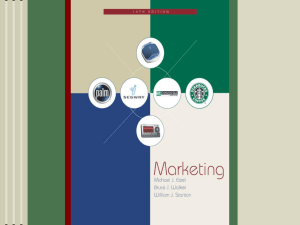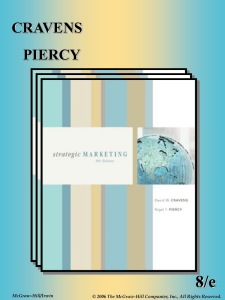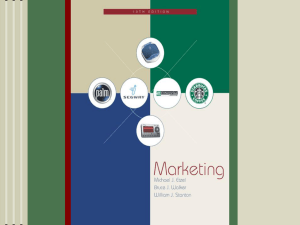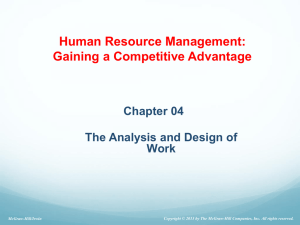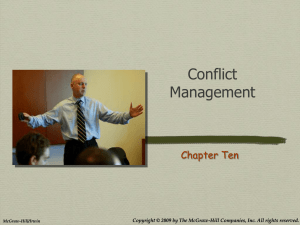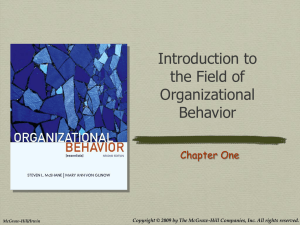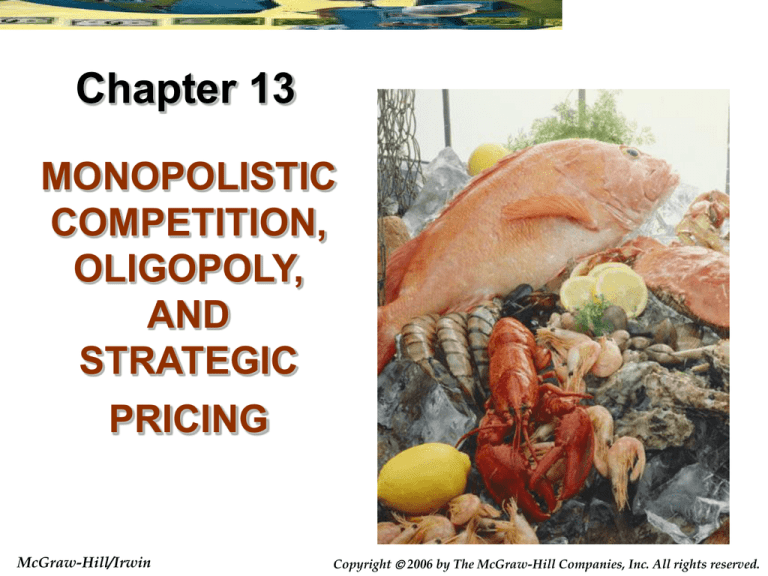
Chapter 13
MONOPOLISTIC
COMPETITION,
OLIGOPOLY,
AND
STRATEGIC
PRICING
McGraw-Hill/Irwin
Copyright 2006 by The McGraw-Hill Companies, Inc. All rights reserved.
13-2
Today’s lecture will:
• Explain two methods of determining
•
•
market structure.
Discuss the four distinguishing
characteristics of monopolistic
competition.
Demonstrate graphically the
equilibrium of a monopolistic
competitor.
McGraw-Hill/Irwin
Copyright 2006 by The McGraw-Hill Companies, Inc. All rights reserved.
13-3
Today’s lecture will:
• Identify the central element of oligopoly.
• Explain why decisions in the cartel
•
model depend on market share and
decisions in the contestable market
model depend on barriers to entry.
Illustrate a strategic decision facing a
duopolist using the prisoner’s dilemma.
McGraw-Hill/Irwin
Copyright 2006 by The McGraw-Hill Companies, Inc. All rights reserved.
13-4
Market Structures
• Market structure refers to the physical
•
•
•
characteristics of the market within which
firms interact, such as the number of firms in
the industry and the existence of barriers to
entry.
Perfect competition has an almost infinite
number of firms and no barriers to entry.
Monopoly is a single firm with barriers to
entry.
Monopolistic competition and oligopoly lie
between these two extremes.
McGraw-Hill/Irwin
Copyright 2006 by The McGraw-Hill Companies, Inc. All rights reserved.
13-5
Market Structures
• Monopolistic competition is a market
•
structure, with few barriers to entry,
in which there are many firms selling
differentiated products.
Oligopoly is a market structure, often
with significant barriers to entry, in
which there are a few interdependent
firms.
McGraw-Hill/Irwin
Copyright 2006 by The McGraw-Hill Companies, Inc. All rights reserved.
13-6
Problems Determining Market
Structure
• What is an industry and what is its
•
geographic market – local, national,
or international?
What products are to be included in
the definition of an industry?
McGraw-Hill/Irwin
Copyright 2006 by The McGraw-Hill Companies, Inc. All rights reserved.
13-7
Classifying Industries
• Cross-price elasticity measures the
responsiveness of the change in demand for
a good to a change in the price of a related
good.
Goods with a cross-price elasticity of 3 or more are
in the same industry.
• North American Industry Classification
System (NAICS) is an industry classification
system adopted by Canada, Mexico, and the
U.S. in 1997.
McGraw-Hill/Irwin
Copyright 2006 by The McGraw-Hill Companies, Inc. All rights reserved.
13-8
Classifying Industries
Under the NAICS
• All firms are placed into 20 broadly
•
•
defined two-digit sectors.
These two-digit sectors are further
divided into subgroupings of three to
six digits.
Subgroupings with more digits are
more narrowly defined.
McGraw-Hill/Irwin
Copyright 2006 by The McGraw-Hill Companies, Inc. All rights reserved.
13-9
Industry Groupings in NAICS
44-45 Retail Trade
513 Broadcasting and telecommunications
51
Information __
5133 Telecommunications
51332 Wireless telecommunications carriers,
except satellite
513321 Paging
52 Finance and insurance
53 Real estate and rental and leasing
McGraw-Hill/Irwin
Copyright 2006 by The McGraw-Hill Companies, Inc. All rights reserved.
13-10
Determining Industry
Structure
• Economists use one of two methods
to measure industry structure:
The concentration ratio – the value of
sales by the top firms of an industry as
a percentage of total industry sales
The Herfindahl index – the sum of the
squared value of the individual market
shares of all firms in the industry
McGraw-Hill/Irwin
Copyright 2006 by The McGraw-Hill Companies, Inc. All rights reserved.
13-11
Concentration Ratio
• The most commonly used
•
concentration ratio is the four-firm
concentration ratio.
The higher the ratio, the closer the
industry is to an oligopolistic or
monopolistic type market of market
structure.
McGraw-Hill/Irwin
Copyright 2006 by The McGraw-Hill Companies, Inc. All rights reserved.
13-12
Herfindahl Index
• The Herfindahl Index is used as a
•
rule of thumb by the Justice
Department to determine whether a
merger should be allowed.
If the index is less than 1000, the
industry is considered competitive,
thus allowing the merger to take
place.
McGraw-Hill/Irwin
Copyright 2006 by The McGraw-Hill Companies, Inc. All rights reserved.
13-13
Concentration Ratios and the
Herfindahl Index
Industry
Meat products
Breakfast cereal
Book printing
Greeting card publishing
Soap and detergent
Men’s footwear
Electronic computer
Burial caskets
Radio, TV, wireless
Four-firm
Herfindahl
concentration
index
ratio
35
82
32
66
60
50
45
74
49
393
2,445
364
1,619
1,306
857
728
2,965
972
broadcasting
McGraw-Hill/Irwin
Copyright 2006 by The McGraw-Hill Companies, Inc. All rights reserved.
13-14
Conglomerate Firms
and Bigness
• Neither the four-firm concentration
•
ratio or the Herfindahl index gives a
complete picture of corporations’
bigness because many firms are
conglomerates.
Conglomerates – huge corporations
whose activities span various
unrelated industries.
McGraw-Hill/Irwin
Copyright 2006 by The McGraw-Hill Companies, Inc. All rights reserved.
13-15
The Importance of Classifying
Industry Structure
• The number of firms in an industry is important
•
•
in determining whether firms explicitly take
other firms’ actions into account.
In oligopoly, with few firms, each firm engages
in strategic decision making – taking explicit
account of a rival’s expected response to its
decisions.
Monopolistic competitors do not engage in
strategic decision making.
McGraw-Hill/Irwin
Copyright 2006 by The McGraw-Hill Companies, Inc. All rights reserved.
13-16
Characteristics of
Monopolistic Competition
• Many sellers
Collusion and strategic decision making is difficult,
so monopolistically competitive firms act
independently.
Gives monopolistic competition its competitive
aspect.
• Differentiated products
Gives monopolistic competition its monopolistic
aspect.
Differentiation exists so long as advertising
convinces buyers that it exists.
McGraw-Hill/Irwin
Copyright 2006 by The McGraw-Hill Companies, Inc. All rights reserved.
13-17
Characteristics of
Monopolistic Competition
• Multiple dimensions of competition
Product differentiation
Perceived quality
Competitive advertising
Service and distribution outlets
• Easy entry of new firms in the long run
There are no significant barriers to entry.
Ease of entry limits long-run profit.
McGraw-Hill/Irwin
Copyright 2006 by The McGraw-Hill Companies, Inc. All rights reserved.
13-18
Price
Equilibrium in
Monopolistic Competition
MC
ATC
Profit maximizing
output is where
MR=MC.
PM
MR
0
McGraw-Hill/Irwin
QM
D
At equilibrium
P=ATC and
economic profits
are zero.
Quantity
Copyright 2006 by The McGraw-Hill Companies, Inc. All rights reserved.
13-19
Comparing Perfect and
Monopolistic Competition
Perfect competition
Price
Monopolistic competition
Price
MC
MC
ATC
ATC
PC
PM
PC
D
MR
D
0
McGraw-Hill/Irwin
QC
Quantity
0
QM
QCQuantity
Copyright 2006 by The McGraw-Hill Companies, Inc. All rights reserved.
13-20
Comparing Perfect and
Monopolistic Competition
• The perfect competitor’s demand curve is
•
perfectly elastic, but the monopolistic
competitor has a downward sloping demand
curve.
Both make zero economic long-run profit.
In perfect competition P = minimum ATC.
In monopolistic competition, P = ATC, but not
minimum ATC.
• Increasing market share is relevant for a
monopolistic competitor, but not for a perfect
competitor.
McGraw-Hill/Irwin
Copyright 2006 by The McGraw-Hill Companies, Inc. All rights reserved.
13-21
Comparing Monopolistic
Competition with Monopoly
• It is possible for the monopolist to
•
make economic profit in the long run
because of the existence of barriers
to entry.
No long-run economic profit is
possible in monopolistic competition
because there are no significant
barriers to entry.
McGraw-Hill/Irwin
Copyright 2006 by The McGraw-Hill Companies, Inc. All rights reserved.
13-22
Advertising and
Monopolistic Competition
• Perfectly competitive firms have no
•
•
incentive to advertise, but
monopolistic competitors do.
The goals of advertising are to
increase demand and make it more
inelastic.
Advertising increases ATC.
McGraw-Hill/Irwin
Copyright 2006 by The McGraw-Hill Companies, Inc. All rights reserved.
13-23
Characteristics of Oligopoly
• Oligopolies are made up of a small
•
•
number of mutually interdependent
firms.
Each firm must take into account the
expected reaction of other firms.
Oligopolies can be collusive or
noncollusive.
McGraw-Hill/Irwin
Copyright 2006 by The McGraw-Hill Companies, Inc. All rights reserved.
13-24
Models of Oligopoly Behavior
• There is no single model of oligopoly
•
behavior.
Two models of oligopoly behavior are:
The cartel model – the combination of
firms acts as if it were a monopoly.
The contestable market model – existence
of barriers to entry determine price and
output decisions.
McGraw-Hill/Irwin
Copyright 2006 by The McGraw-Hill Companies, Inc. All rights reserved.
13-25
The Cartel Model
• Oligopolies act as if they were a monopoly
•
•
and set a price to maximize profit.
Output quotas are assigned to individual
member firms so that total output is
consistent with joint profit maximization.
If oligopolies can limit the entry of other
firms, they can increase profits.
McGraw-Hill/Irwin
Copyright 2006 by The McGraw-Hill Companies, Inc. All rights reserved.
13-26
Implicit Price Collusion
• Formal collusion is illegal in the U.S. while
•
•
informal collusion is permitted.
Implicit price collusion exists when
multiple firms make the same pricing
decisions even though they have not
consulted with one another.
Sometimes the largest or most dominant
firm takes the lead in setting prices and
the others follow.
McGraw-Hill/Irwin
Copyright 2006 by The McGraw-Hill Companies, Inc. All rights reserved.
13-27
Why Are Prices Sticky?
• Informal collusion is an important
•
reason why prices are sticky.
Another is the kinked demand curve.
If a firm increases price, others won’t go
along, so demand is very elastic for
price increases.
If a firm lowers price, other firms match
the decrease, so demand is inelastic for
price decreases.
McGraw-Hill/Irwin
Copyright 2006 by The McGraw-Hill Companies, Inc. All rights reserved.
13-28
The Kinked Demand Curve
Price
a
P
b
MR1
MC0
c
MC1
D1
d
D2
0
McGraw-Hill/Irwin
Q
MR2
Quantity
Copyright 2006 by The McGraw-Hill Companies, Inc. All rights reserved.
13-29
The Contestable Market Model
• According to the contestable market
•
model, barriers to entry and exit
determine a firm’s price and output
decisions.
Even if the industry contains only
one firm, it will set a competitive
price if there are no barriers to entry.
McGraw-Hill/Irwin
Copyright 2006 by The McGraw-Hill Companies, Inc. All rights reserved.
13-30
Comparing the Contestable
Market and Cartel Models
• The cartel model is appropriate for oligopolists
•
•
•
that collude, set a monopoly price, and prevent
market entry.
The contestable market model describes
oligopolies that sets a competitive price and
has no barriers to entry.
Oligopoly markets lie between these two
extremes.
Both models use strategic pricing decisions –
firms set their price based on the expected
reactions of other firms.
McGraw-Hill/Irwin
Copyright 2006 by The McGraw-Hill Companies, Inc. All rights reserved.
13-31
New Entry and Price Wars
• The threat of outside competition limits
•
•
oligopolies from acting as a cartel.
Price wars are the result of strategic
pricing decisions gone wild.
A predatory pricing strategy involves
temporarily pushing the price down in
order to drive a competitor out of
business.
McGraw-Hill/Irwin
Copyright 2006 by The McGraw-Hill Companies, Inc. All rights reserved.
13-32
Game Theory and Strategic
Decision Making
• Most oligopolistic strategic decision making is
•
•
•
carried out with explicit or implicit use of game
theory.
Game theory is the application of economic
principles in which players make
interdependent choices.
The prisoner’s dilemma is a game that
demonstrates the difficulty of cooperative
behavior in certain circumstances.
The prisoner’s dilemma can be applied to a
duopoly – a two firm oligopoly.
McGraw-Hill/Irwin
Copyright 2006 by The McGraw-Hill Companies, Inc. All rights reserved.
13-33
MC
$800
Price
Price
Firm and Industry Duopoly
Cooperative Equilibrium
ATC
$800
700
700
600
575
500
600
400
400
300
300
200
200
100
100
Monopolist
solution
Competitive
solution
500
0
1 2 3 4 5 6 7 8
Quantity (in thousands)
Firm's cost curves
McGraw-Hill/Irwin
MC
D
0
MR
1 2 3 4 5 6 7 8 9 10 11
Quantity (in thousands)
Industry: Competitive and monopolist solution
Copyright 2006 by The McGraw-Hill Companies, Inc. All rights reserved.
13-34
Firm and Industry Duopoly
Equilibrium When One Firm Cheats
P
MC ATC
$800
MCATC
$800
P
$900
800
700
700
700
600
550
500
600
550
500
600
550
500
A
A
400
300
300
200
200
200
100
100
100
1 2 3 4 5 6 7
Quantity (in thousands)
Noncheating firm’s loss
McGraw-Hill/Irwin
0
1 2 3 4 5 6 7
Quantity (in thousands)
Cheating firm’s profit
B
A
Non- Cheating
400 cheating firm’s
300 firm’s output
output
400
0
C
0
1 2 3 4 5 6 7 8
Quantity (in thousands)
Cheating solution
Copyright 2006 by The McGraw-Hill Companies, Inc. All rights reserved.
13-35
Duopoly and a Payoff Matrix
• A payoff matrix is a box that contains
•
the outcomes of a strategic game
under various circumstances.
By analyzing the strategies of both
firms under all situations, all
possibilities are placed in a payoff
matrix.
McGraw-Hill/Irwin
Copyright 2006 by The McGraw-Hill Companies, Inc. All rights reserved.
13-36
The Payoff Matrix of Strategic
Pricing Duopoly
A Does not cheat
A Cheats
A +$200,000
A $75,000
B Does not
cheat
B $75,000
B – $75,000
A – $75,000
A0
B Cheats
B +$200,000
McGraw-Hill/Irwin
B0
Copyright 2006 by The McGraw-Hill Companies, Inc. All rights reserved.
13-37
Comparison of Market Structures
Structure
Monopoly
Oligopoly
Monopolistic
Competition
Perfect
Competition
Number of Firms
One
Few
Many
Almost infinite
Barriers to Entry
Significant
Significant
Few
None
MC=MR
Strategic pricing,
between monopoly
and competition
MC=MR
MC=MR=P
No output
restriction
Characteristics
Pricing Decisions
Output Decisions
Most output
restriction
Output somewhat
restricted
Output somewhat
restricted by
product
differentiation
Interdependence
No competitors
Interdependent
decisions
Each firm
independent
Each firm
independent
Long-Run Profit
Possibility
Possibility
None
None
P and MC
P>MC
P>MC
P>MC
P=MC
McGraw-Hill/Irwin
Copyright 2006 by The McGraw-Hill Companies, Inc. All rights reserved.
13-38
Summary
• Industries are classified by economic activity
•
•
in the North American Industry Classification
System (NAICS). Industry structures are
measured by concentration ratios and
Herfindahl indexes.
A concentration ratio is the sum of market
shares of the largest firms in an industry.
A Herfindahl index is the sum of the squares of
the market shares of all firms in an industry.
McGraw-Hill/Irwin
Copyright 2006 by The McGraw-Hill Companies, Inc. All rights reserved.
13-39
Summary
• The central characteristic of oligopoly is
•
that there are a small number of
interdependent firms.
Monopolistic competition is
characterized by:
Many sellers
Differentiated products
Multiple dimensions of competition
Ease of entry of new firms
McGraw-Hill/Irwin
Copyright 2006 by The McGraw-Hill Companies, Inc. All rights reserved.
13-40
Summary
• Monopolistic competitors differ from perfect
•
•
competitors in that the former face a
downward sloping demand curve.
Monopolistic competitors differ from
monopolists in that monopolist competitor
make zero long-run profit.
In monopolistic competition firms act
independently; in an oligopoly they take
account of each other’s actions.
McGraw-Hill/Irwin
Copyright 2006 by The McGraw-Hill Companies, Inc. All rights reserved.
13-41
Summary
• An oligopolist’s price will be somewhere
•
•
•
between the competitive price and the
monopolistic price.
Game theory and the prisoner’s dilemma can
shed light on strategic pricing decisions.
A contestable market theory of oligopoly
judges an industry’s competitiveness more by
performance and barriers to entry than by
structure.
Cartel models of oligopoly concentrate on
market structure.
McGraw-Hill/Irwin
Copyright 2006 by The McGraw-Hill Companies, Inc. All rights reserved.
13-42
Review Question 13-1 Explain the difference in short-run
and long-run equilibrium for a monopolistic competitor.
In the short-run, a monopolistic competitor produces
where MR=MC. As long as P>ATC, the firm will make an
economic profit. However, other firms enter the industry
and decrease the market share of the original firms. The
demand curve of these firms shifts to the left until P=ATC
and there are no economic profits in long-run equilibrium.
Review Question 13-2 Compare long-run equilibrium in
oligopoly with respect to price and output with perfect
competition and monopoly.
Equilibrium output for oligopoly is larger than output for a
monopoly, but less than output for a perfectly competitive
firm. Prices in oligopoly are lower than those for
monopoly, but higher than those in perfect competition.
McGraw-Hill/Irwin
Copyright 2006 by The McGraw-Hill Companies, Inc. All rights reserved.




